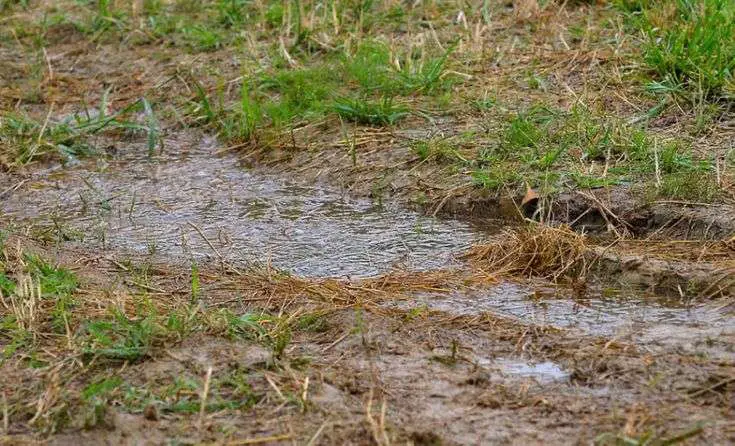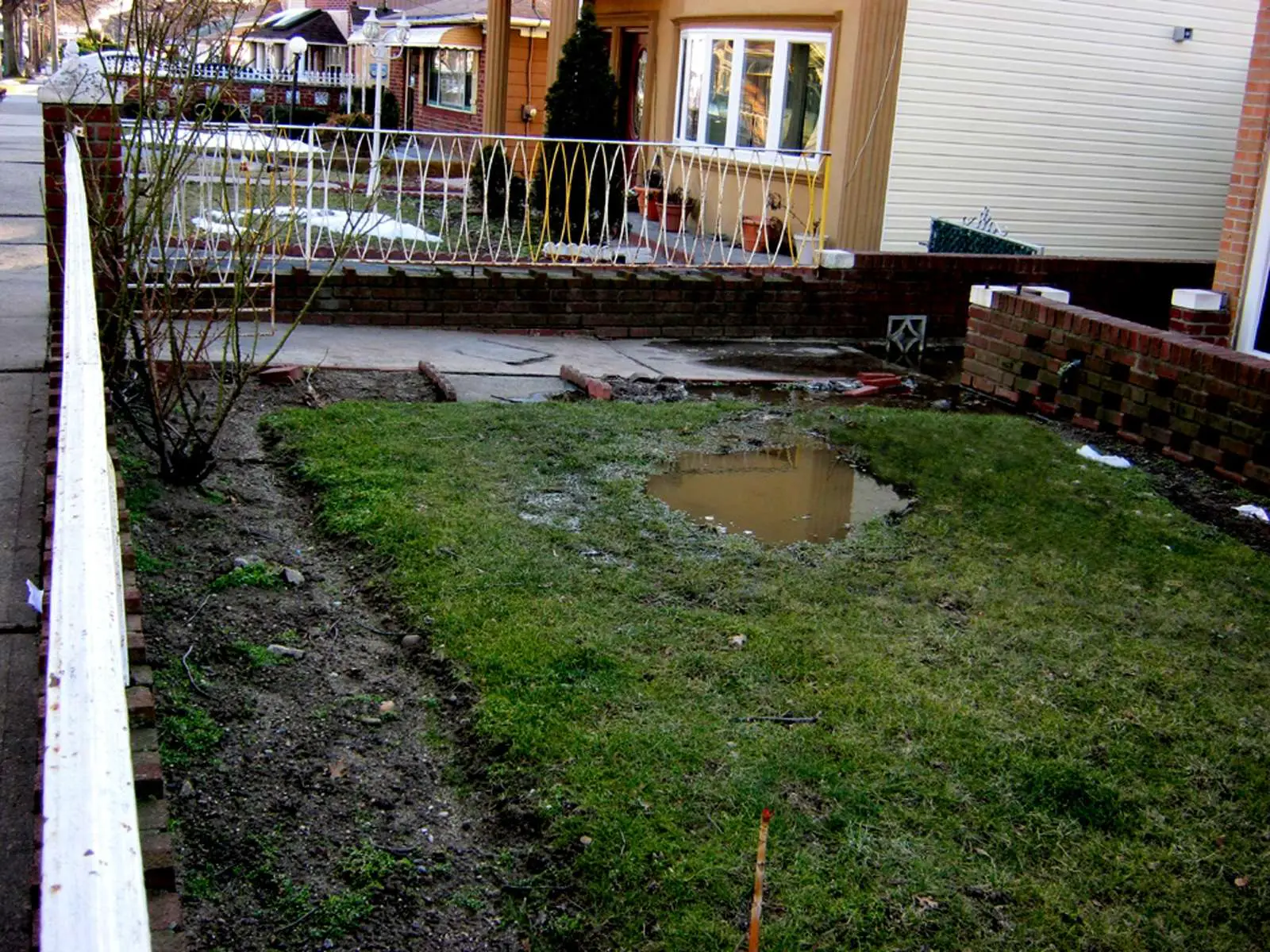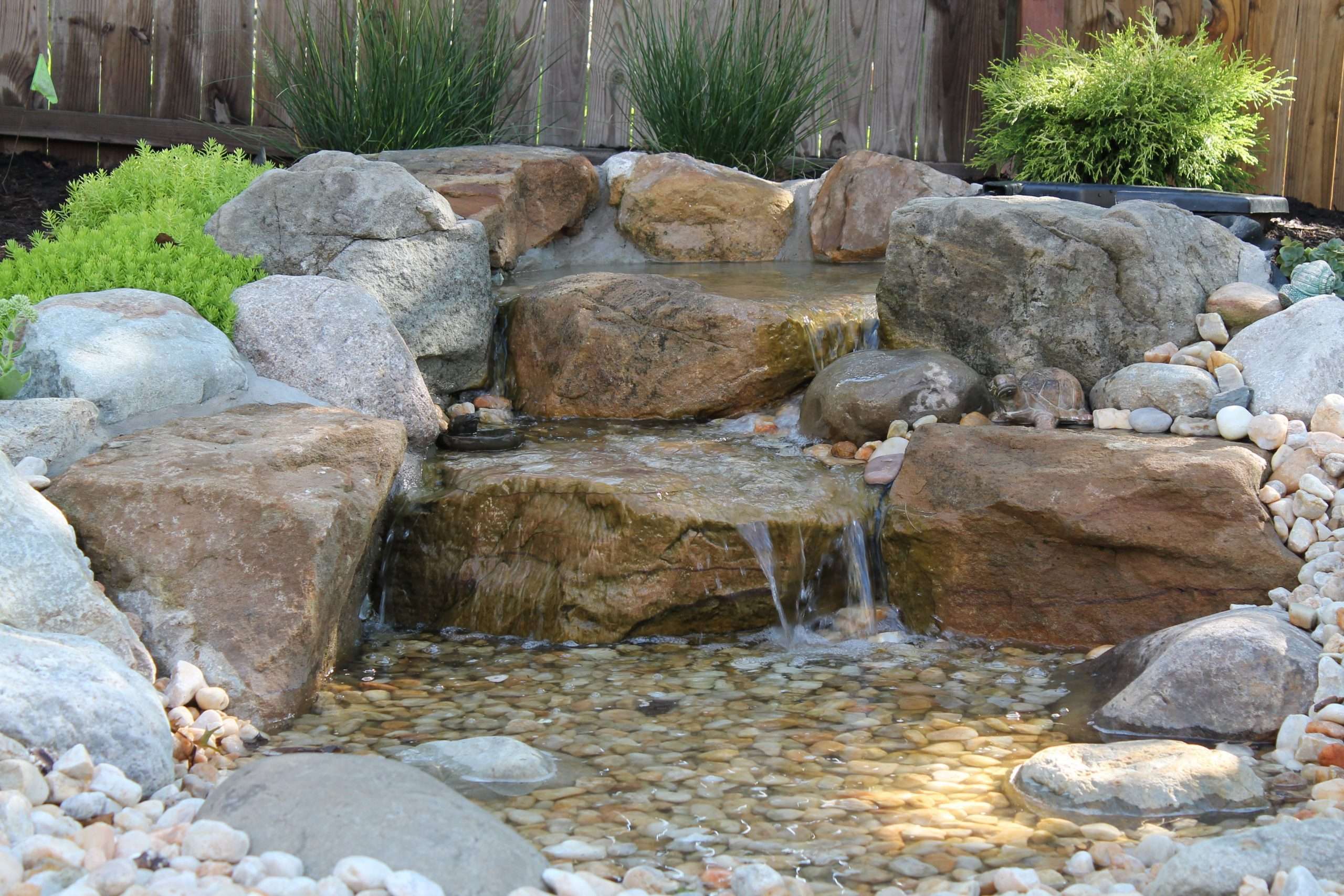Other Backyard Drainage Problems And Solutions
If weve learned anything in the years that weve been helping people with their landscape issues, its that there are as many specific drainage problems and solutions as there are yards. However, most of them fall into the basic categories already detailed above.
That being said, here are a few more issuesand solutionswe havent discussed:
Diverting The Water Underground
In case of a rainstorm, water rushes through the gutters and into the downspouts, and if it isnt able to runoff easily, it can contribute to the flooding in your yard. You dont want that to happen.
The problem could be caused due to a variety of reasons, such as low spots or improper grading, but the best solution is to divert it all under the ground.
You should consider installing a French drain or a perforated underground drain pipe that collects all of the water from the gutters above and carries it straight to the sewer system.
Improve The Yard Grade
The slope of your yard determines where and how rainwater will drain, making it the single most important factor in preventing your yard from flooding. For efficient drainage, your yard should have a minimum slope of 2 percent away from your housethat’s a fall of two feet for every 100 linear feet of yard.
If your yard doesnt have adequate slope, water can pool in various areas or even back up along the foundation of your house, where it can lead to leaks and serious foundation problems. You can improve the grade by spreading topsoil along the foundation and in low areas to facilitate drainage.
Recommended Reading: How To Treat Algae In Pool
Dry Wells & Runoff Water
When setting up your drainage, make sure that you are not turning your problem into one for your neighbors. The runoff should be diverted into the city drain, or into a dry well. This is basically a large hole filled with rocks and covered with a grate. Water will collect in this area and evaporate during warmer weather. When creating a dry well, make sure that you opt for larger instead of smaller. Rainfall is often unpredictable, and the last thing you need is for your drywell to fill up and send all that water back into your yard. The average size for a dry well is four feet wide and four feet deep, but you can always make it larger if the rainy season in your area tends to be heavier.
It is also common for property owners to create two or three dry wells in different areas to prevent anyone well from getting overloaded. A bit of creativity can turn a low spot problem into a beautiful, natural-looking runoff creek that runs through your yard.
Diverting Water From The Foundation Of Your House

Typically, when people contact a home services company about drainage issues, theyre worried about specific pools of standing water out in the yard. However, theres another issue that can end up causing far bigger problemsworse, it may be largely invisible in many cases.
What are we talking about? Water encroaching on your homes foundation. This scenario can be a problem for a number of reasons.
First of all, water near your homes foundation can cause cracks and remove soil supporting the slab and the footings, which can lead to wall problems. If you have a basement, water can actually seep through the walls and into your home.
Repairing these issues can be quite expensive, and really isnt something you want to have to deal with.
Fortunately, you have several options to keep water away from your foundation, all of which we already mentioned which can help with other drainage issues you may be experiencing.
Also Check: How Much Value Does Pool Add To House
What To Do With A Pool Leak
A leaking pool can do just as much damage as an open, dried pool, when it comes to stagnant water. When your standing water is caused by a leak, the water seeps into nearby soil, which can cause compaction and dips in your soil.
Telltale signs of a leaky pool being the cause of your stagnant water include:
- Noticeable cracks or tears in the pool. If you can see the holes, its clear youve got a leak.
- Missing water. Does the pool never seem to stay entirely full? It could be a leak in the plumbing, or could be a sign that your pool has a small crack in it that causes leaks.
- A muddy patch that never seems to go away. If the patch lines up with pool plumbing, chances are that you have a leak in the piping that keeps your water in there.
- Standing water near your pool, despite dry weather. The water has to come from somewhere. If this is happening around your lawn frequently, it could be due to an unseen pool leak.
If you have a leaking pool, you are going tohave to find the source of the leak and fix it. With above-ground pools, thismay be a DIY project. However, if it involves an in-ground pool withspecialized plumbing, calling a trained professional is advisable.
What Causes Backyard Drainage Issues
Many factors can cause backyard drainage issues, and the first step in fixing your drainage issues is finding out what is causing it. Some common causes of backyard drainage issues are:
- compacted soil
- improper backyard grading and sloping
- poorly maintained eavestrough and downspouts
- improper installation of landscape features like a fence or deck
Once youve identified the causes of your backyard drainage issues, there are a few different solutions you can choose to use to address these issues. Some are pretty straightforward and can be DYId, but others will require professional intervention. Problems that require yard grading and sloping should be done by a professional. Still, other external factors like excess water due to poorly maintained eavestrough and downspouts should be easy enough to tackle yourself.
You May Like: How Much Does An Underground Pool Cost
How To Fix Water Pooling Around Your Sprinkler Head
For our DIY readers, we found a great step by step video on how to fix a leaking sprinkler head here. However, if you notice your sprinkler head leaking while running or any of these issues with your homes irrigation system, well always recommend you for repair right away.
The longer you wait to fix the problem, the more water damage you may accidentally cause in your backyard!
An experienced irrigation repair technician will be able to diagnose the problem with your sprinklers systems and provide a recommended solution.
If the problem is beyond repair, we may recommend a replacement irrigation system.
Common Causes Of Water Coming Out Of Ground In Yard
When water is pooling in your yard there are a few common causes that we recommend checking right away. Most of the time the drainage problem is caused by one of the following:
Broken water main: A broken water main is the most likely cause if there are large puddles of water. If this line is broken it will need to be dug up and repaired or replaced
Leaking sprinkler head: A leaking sprinkler head or leaking sprinkler system can cause a surprisingly large leak for such a small piece of equipment.
Broken water line: Other broken water and drainage lines can leak underground and eventually pool in the soil.
Malfunctioning sump pump:Broken sump pumps can cause a flood insider your home, or leak outside.
Clogged drain lines: Clogged drain lines can backup water into your home or break the water line, causing a leak. Clay soil tends to have more problems.
Downspouts and Runoff: Gutters, downspouts, a retaining wall problem or other drainage issues can all cause pooling in the yard. Check there is no damage to the gutters and the downspouts still point the water runoff in the right area.
Don’t Miss: Don Johnson Pool And Spa
Concrete Patio Drainage Options That Prevent Standing Water
Do portions of your concrete patio or pool deck sit under water after a heavy rain, ruining your outdoor activities? Thats a sure sign that your patio isnt draining properly. Poor patio drainage not only spoils your outdoor fun, it can also allow water to seep into your basement if the water pools next to your house. Here are some tips for identifying and correcting aggravating and potentially destructive patio drainage problems.
For this patio, strips of decorative gravel offer an attractive drainage solution. Modal Design in Los Angeles, CA.
How To Find Buried Sprinkler Heads
Oftentimes, when water is pooling in your yard it can be due to a buried sprinkler head. This typically happens as seasons shift and silt or debris is transferred around when the snows melt.
If your buried head is surrounded by a pool of water, it should be easy enough to locate, but what if the pool has dried out by the time youre ready to tackle the problem?
There are a few ways to find buried sprinkler heads . Our favorite way is by using an underground wire and sprinkler valve locator, or by simply referring to the installation plan for your system and measuring out from a known head location. There are even those who swear they can find underground sprinkler pipes by simply holding a coat hanger in their hands.
Read Also: How To Clean Gunite Pool Stains
Removing Water From Flooded Patios
Water might begin to pool up on your patio and the sidewalk, close to the yard. Needless to say, this water can take more than a week or so to evaporate on its own.
So, its obvious that you need to take action because the paved areas will become completely unusable.
Raising the level of the patio or the sidewalk is obviously going to cost too much money, so a better option is to install a storm drain channel. They can be installed along the sidewalk and can eventually connect with a buried French drain, which will carry all of the excess water to the main sewer system out on the street.
These grates are also pretty attractive, so you dont have to worry about aesthetic appeal either.
About Septic Tank Overflow Into Yard

By its design, a septic system is expected to hold and treat wastewater before filtering the same in the drain field.
A scenario where wastewater collects or pools around your yard is unacceptable and must be remedied as fast as possible.
Now, such pooling water is only the symptom of the problem. Youll need to look beyond such pooling water to the cause of the problem. Now, pinpointing the problem isnt so automatic.
In other words, there are many possible reasons why septic tank water will pool around your yard.
Here, well be listing several possible causes why youre experiencing pooling water. The further probe should reveal or unmask the real problem. Locating the problem is where it all begins.
Necessary action is taken to address such issues. Are you ready? Lets go!
Read Also: How Much Bleach For 10000 Gallon Pool
Health Risks Of Standing Water In A Yard
Allowing water to pool on your lawn causes a variety of health risks, including:
- Mold: Mold loves to grow in moist environments, specifically standing water in your home. You mustnt allow pooling water near your homes foundation as mold can begin to grow up the walls, and as spores spread, the entire foundation could get contaminated. This can be costly and have hazardous health effects for you and your family.
- Bacteria: Large moist pools of water make the perfect ecosystem for pathogens such as E. coli, viruses, and other bacteria that can cause severe illnesses for humans and their pets.
- Insects: Various bugs like mosquitoes find pooling water to be the perfect breeding ground and magnify populations that carry diseases like West Nile virus, malaria, Zika virus, and encephalitis.
- Vermin: Rodents like rats, mice, and possums are attracted to standing water for nesting and watering holes and can spread disease to surrounding humans and animals.
- Algae: There is a high risk of algae blooming in pooling water, and some types of algae can produce harmful toxins.
Stop Water Pooling In Your Yard For Good
Do you cringe every time it rains knowing your home will soon be surrounded by unintentional ponds and puddles? Not only is standing water unsightly, but it can destroy landscaping, damage your foundation, and become a breeding ground for bugs and bacteria. Luckily, there are some tried and true methods landscaping and drainage contractors can turn to in order to fix water pooling in your yard.
Read Also: What Kind Of Shock For Salt Water Pool
Common Causes Of Yard Drainage Issues
There are several factors that can lead to a yard failing to vacate excess water properly. Different causes of yard drainage problems can call for different solutions and DIY approaches. The following are some of the most common reasons your yard may be draining poorly.
- Yard slope or pitch: In many cases, water pools in a yard because the soils flat plane doesnt divert enough water away from the house.
- A too-short downspout: If your gutters downspout points directly into a flower bed or other landscaped area, excess water can collect in the mulch and soil beneath.
- Impacted soil: This can be a result of construction projects, such as in-ground pools, around the house. Hardpan clay is especially problematic when impacted, as it can retain moisture for far longer than other types of soil.
- Front walkways: If a sidewalk or concrete path sits in front of your house, it could be blocking off water, preventing it from running through your yard and into the storm drain.
- Runoff erosion: If the runoff from your downspout has stripped away some of the topsoil in your yard, this can lead to heavy collection beneath the eroded area.
How To Fix Your Lawn Pooling
Lawn pooling causes diseases and kills grass roots, but simple maintenance tasks often solve the problem. A lawn should slope slightly away from the house and toward the street or other water outlet. Incorrectly graded lawns can suffer from pooling that’s difficult to correct without professional help, but regular dethatching and aerating a lawn solve most pooling problems and promotes vigor. Check irrigation levels before digging drainage channels, which provide a solution to permanently poor drainage.
Also Check: What Is The Best Manual Pool Vacuum
Significant Vegetation Changes Impacting Gradients
Unplanned vegetation changes sometimes alter drainage patterns. These transformations sometimes impact a lawn significantly, also. For instance, following a brush fire that strips away vegetation, the sudden lack of ground covering creates water runoff issues in some locations. Landscaping may assist this problem.
Install Ez Drain French Drain Piping
Make no mistake, I carefully weighed my options when it came to the type of french drain system that I wanted to install.
With the rental house, which we tackled first, I used traditional flexible corrugated drainage pipe. We went to Home Depot and purchased around 200 feet of it .
We also had to haul a couple of trailers filled with rock. The rock could have been carried in one trip but the weight prevented it.
The way a traditional french drain system is installed involves first lining the bottom of the trench with a semipermeable membrane fabric .
Next, you spread a layer of rock, then lay the drainage pipe. Finally, you cover the piping with more of the semipermeable membrane, possibly more rock, and finally backfill with dirt.
I didnt get any pictures during this part of the process because we were frustrated and exhausted from the process. I will never do it this way again.
The EZ Drain system is totally different. Instead of having to use rock, the drainage pipe is surrounded by styrofoam particles like you might find in a shipping package. It is wrapped with a white pantyhose type of material. This serves as the semipermeable membrane. Its literally an all-in-one french drain solution! All we had to do was lay it in the trench, connect it together, and cover it up.
You can see here where we filled part of the hole with some of the loose styrofoam fillers. We tore one apart because my son wanted to see how they were made.
Recommended Reading: Where To Buy Plastic Pool
What Professional Is Best Equipped To Provide A Drainage Solution
At M2 Landscaping in Northern IL, we specialize in landscape drainage solutions. Our goal is to stop the water before it enters your house and to create a beautiful and safe outdoor environment.
Some issues, such as standing water in your yard, are clearly an outdoor issue. A landscape professional can help you diagnose the cause of this problem and find a solution.
Water in your basement can be trickier to diagnose because the cause may not be readily apparent. At M2 Landscaping, we will assess your outdoor situation to see if it is causing the drainage issue.
If we determine the problem will not be solved by fixing something outside your home, we will refer you to a reputable waterproofing company that can help solve the problem from inside your home.
In most cases though, water inside the home starts from a problem outside.
What Are The Signs Of A Water Drainage Problem

A lake-sized puddle may be a little dramatic. The indicators of drainage issues in your yard may be a little more subtle than that. Here are a few telltale signs that indicate you need to divert water in your yard:
- Overflowing gutters
- Efflorescence or flaking walls in your basement
- Basement leaks
Donât Miss: Mandalay Bay Pool Price
Read Also: How Much To Put In An Inground Pool
